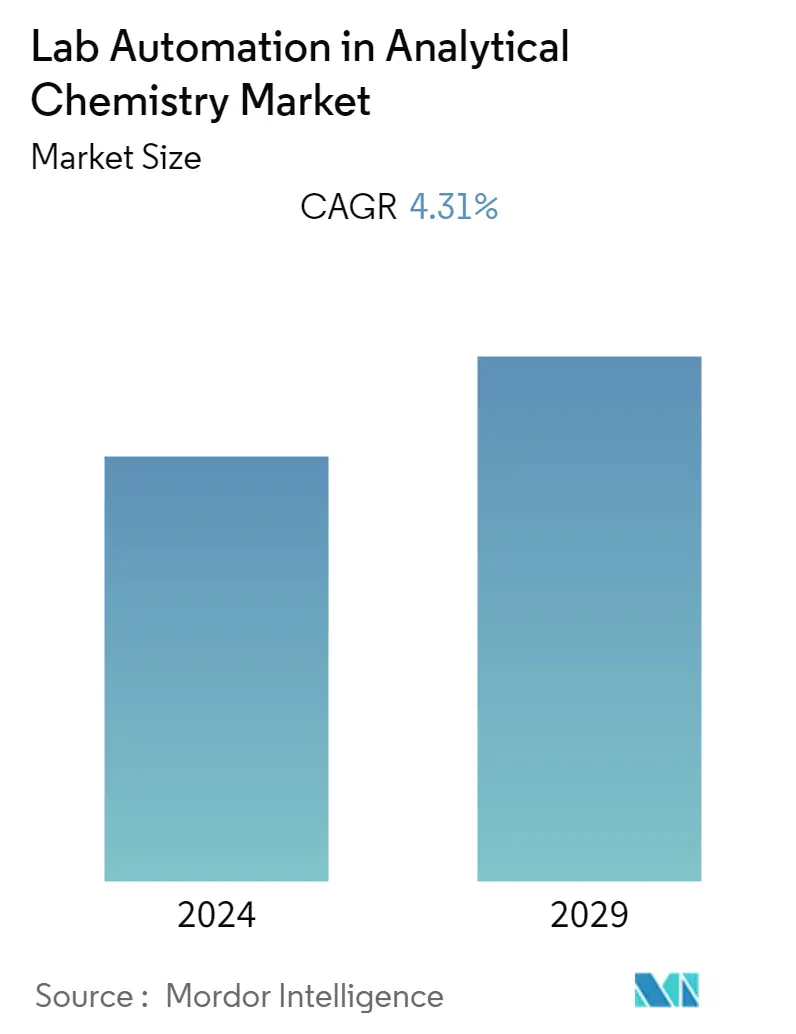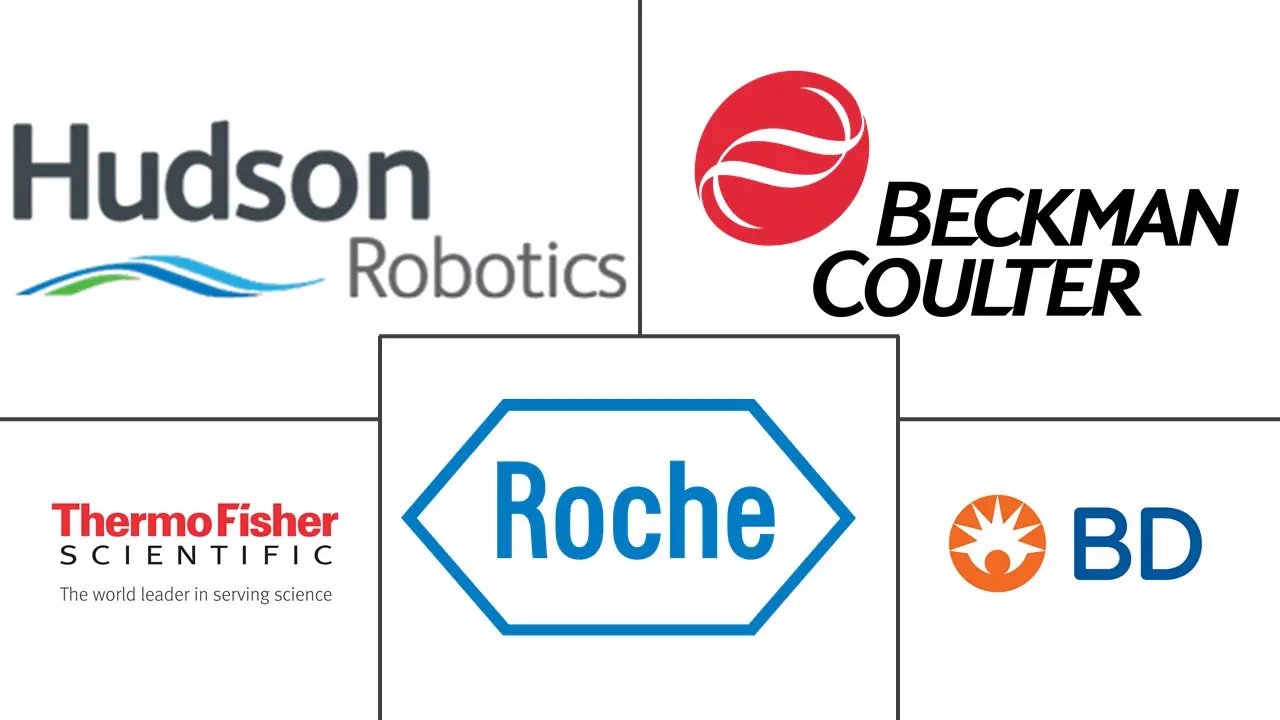Market Size of Lab Automation in Analytical Chemistry Industry

| Study Period | 2019 - 2029 |
| Base Year For Estimation | 2023 |
| CAGR | 4.31 % |
| Fastest Growing Market | Asia Pacific |
| Largest Market | North America |
| Market Concentration | Medium |
Major Players
*Disclaimer: Major Players sorted in no particular order |
Lab Automation In Analytical Chemistry Market Analysis
The Global Lab Automation in Analytical Chemistry Market is expected to register a CAGR of 4.31% % during the forecast period 2020 to 2025. The benefits of laboratory automation in analytical chemistry include reduction of human errors in specimen handling, enhancements in overall process control, and faster turn-around-times (TAT) from specimen collection to test result reporting. The primary goal of diagnostic labs is to provide high quality and reliable information, fulfilling the industry's needs.
- Currently, technological advancements and increasing pressure to deliver results have led to the use of automated systems in laboratories. The adoption rate of automated systems is increasing due to its accuracy, advanced data management capacity, and reduced repetitiveness, and ultimately reducing the human intervention, thereby increasing throughput and accuracy.
- Many core labs are looking to enhance testing efficiency and better manage resources by upgrading to total laboratory automation (TLA). Although total lab automation can be challenging to plan and implement, it is particularly suited to laboratories that conduct a broad spectrum of highly automated testing, coupled with sophisticated laboratory information systems. TLA avoids the duplication, delays, and waste that can occur with task targeted automation.
- Laboratory automation contains computerized lab instruments and gadgets, which give advantages, such as expanded profitability, enhanced work process scope, reduced time cycle, and improved information quality. Lab automation is also vital to handle large volumes of sample tests at a rapid rate.
- In the recent past, Tecan launched a range of advanced liquid handling solutions, along with the new Fluent Gx Automation Workstation, to meet the critical needs of clinical and regulated laboratories. In October 2019, Hamilton launched its compact Microlab Prep automated liquid handler designed for those transitioning away from manual pipetting, using 96- and 384-well microplates and other sample vessels.
- Further, There has been a significance with the pharmaceutical industry toward laboratory automation trends, in the past two decades. Pharmaceutical companies require accurate target identification, and one of the main bottlenecks of drug discovery and development is compound validation. Lab automation is a crucial technology for any company undertaking these studies, offering rapid compound screening and improved data analysis.
- Additionally, with the recent outbreak of novel COVID-19, there is an increasing need for faster results in labs. The growing developments of automation systems by vendors are expected to create opportunities for the market going forward.
Lab Automation In Analytical Chemistry Industry Segmentation
Lab automation or total lab automation is the automation of the repetitive functions performed in a laboratory, leading to the overall improvement in process control, along with leading to faster turnaround times. The study undertakes the segments of the lab automation in the analytical chemistry market, based on the type of equipment into automated liquid handlers, automated plate handlers, robotic arms, automated storage and retrieval systems (ASRS), software, and analyzers.
| By Equipment | |
| Automated Liquid Handlers | |
| Automated Plate Handlers | |
| Robotic Arms | |
| Automated Storage and Retrieval Systems (ASRS) | |
| Software | |
| Analyzers |
| By Geography | |
| North America | |
| Europe | |
| Asia Pacific | |
| Rest of the World |
Lab Automation in Analytical Chemistry Market Size Summary
The Lab Automation in Analytical Chemistry Market is experiencing a transformative phase driven by technological advancements and the increasing need for efficiency in laboratory processes. Automation in laboratories offers significant benefits, including the reduction of human errors, enhanced process control, and faster turnaround times from specimen collection to result reporting. The adoption of automated systems is on the rise due to their accuracy, advanced data management capabilities, and ability to minimize repetitive tasks, thereby increasing throughput. Total laboratory automation (TLA) is gaining traction as it helps avoid duplication, delays, and waste, making it particularly suitable for labs conducting a wide range of highly automated testing. The pharmaceutical industry, in particular, is leveraging lab automation to streamline drug discovery and development processes, addressing bottlenecks in compound validation and data analysis.
North America leads the market, supported by a strong presence of major pharmaceutical companies and contract research organizations. The region's competitive landscape is bolstered by stringent FDA regulations, prompting companies to integrate robotics and automation to gain a competitive edge. Automation solutions are continuously evolving, with companies like Beckman Coulter and Roche Holding AG introducing innovative systems to enhance lab operations. The market is moderately consolidated, with key players focusing on partnerships and collaborations to drive innovation and maintain a competitive advantage. These developments are expected to create further opportunities for growth in the lab automation sector, as vendors continue to meet the increasing demand for faster, more accurate, and efficient laboratory processes.
Lab Automation in Analytical Chemistry Market Size - Table of Contents
-
1. MARKET INSIGHTS
-
1.1 Market Overview
-
1.2 Market Drivers
-
1.2.1 Increasing Investments in R&D by Pharmaceutical and Biotechnology Companies
-
1.2.2 Rising Demand from Drug Discovery and Genomics
-
-
1.3 Market Challenges
-
1.4 Industry Attractiveness - Porter's Five Forces Analysis
-
1.4.1 Threat of New Entrants
-
1.4.2 Bargaining Power of Buyers
-
1.4.3 Bargaining Power of Suppliers
-
1.4.4 Threat of Substitute Products
-
1.4.5 Intensity of Competitive Rivalry
-
-
1.5 Assessment of COVID-19 Impact on the Industry
-
-
2. MARKET SEGMENTATION
-
2.1 By Equipment
-
2.1.1 Automated Liquid Handlers
-
2.1.2 Automated Plate Handlers
-
2.1.3 Robotic Arms
-
2.1.4 Automated Storage and Retrieval Systems (ASRS)
-
2.1.5 Software
-
2.1.6 Analyzers
-
-
2.2 By Geography
-
2.2.1 North America
-
2.2.2 Europe
-
2.2.3 Asia Pacific
-
2.2.4 Rest of the World
-
-
Lab Automation in Analytical Chemistry Market Size FAQs
What is the current Lab Automation in Analytical Chemistry Market size?
The Lab Automation in Analytical Chemistry Market is projected to register a CAGR of 4.31% during the forecast period (2024-2029)
Who are the key players in Lab Automation in Analytical Chemistry Market?
Thermo Fisher Scientific Inc, Roche Holding AG, Beckman Coulter, Hudson Robotics Inc and Becton Dickinson & Co. are the major companies operating in the Lab Automation in Analytical Chemistry Market.

